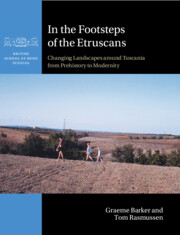Book contents
- In the Footsteps of the Etruscans
- British School at Rome Studies
- In the Footsteps of the Etruscans
- Copyright page
- Dedication
- Contents
- Figures
- Tables
- Contributors
- Preface and Acknowledgements
- 1 The Tuscania Archaeological Survey: Rationale, Aims and Objectives
- 2 Methodologies
- 3 The Natural Landscape and Its Evolution
- 4 Prehistoric Landscapes
- 5 Etruscan Urbanization, c. 700–300 bc
- 6 ‘Romanization’: The Roman Republican Period, c. 300–30 bc
- 7 The Roman Imperial and Late Antique Periods, c. 30 bc–c. ad 700
- 8 Incastellamento and Its Aftermath: Medieval and Modern Landscapes, c. ad 700 to the Present
- 9 A Mediterranean Landscape from Prehistory to Modernity
- Book part
- Bibliography
- Index
5 - Etruscan Urbanization, c. 700–300 bc
Published online by Cambridge University Press: 12 October 2023
- In the Footsteps of the Etruscans
- British School at Rome Studies
- In the Footsteps of the Etruscans
- Copyright page
- Dedication
- Contents
- Figures
- Tables
- Contributors
- Preface and Acknowledgements
- 1 The Tuscania Archaeological Survey: Rationale, Aims and Objectives
- 2 Methodologies
- 3 The Natural Landscape and Its Evolution
- 4 Prehistoric Landscapes
- 5 Etruscan Urbanization, c. 700–300 bc
- 6 ‘Romanization’: The Roman Republican Period, c. 300–30 bc
- 7 The Roman Imperial and Late Antique Periods, c. 30 bc–c. ad 700
- 8 Incastellamento and Its Aftermath: Medieval and Modern Landscapes, c. ad 700 to the Present
- 9 A Mediterranean Landscape from Prehistory to Modernity
- Book part
- Bibliography
- Index
Summary
Before our project Etruscan Tuscania was best known for its great family tombs with inscribed sarcophagi of the 4th-2nd centuries BC, but the survey evidence shows that the Etruscan landscape was most densely settled in the 6th century BC (219 sites), coincident with the process of urbanization. The frequency of ‘off-site’ material indicates that Etruscan agricultural activity extended over the greater part of the surveyed area. Little survives of the remains of the Etruscan town, but the richness of Etruscan material immediately south of the city walls indicates a suburban extension of it. The development of Tuscania implies that the control of minor centres by major centres (or rather, the control of less powerful by more powerful families as social and economic inequalities became increasingly marked) was one of the earliest features of Etruscan urbanization. The Archaic Etruscan phase was followed by a marked, though not dramatic, population decline in the Later Etruscan phase (129 sites), the fifth and fourth centuries BC. Activities at Guidocinto, a small but long-lived Etruscan farm we excavated near Tuscania, included the production and processing of oil, wine, and wool, products that enhanced elite lifestyles and provided them with valuable resources for exchange and trade.
Keywords
- Type
- Chapter
- Information
- In the Footsteps of the EtruscansChanging Landscapes around Tuscania from Prehistory to Modernity, pp. 130 - 175Publisher: Cambridge University PressPrint publication year: 2023



